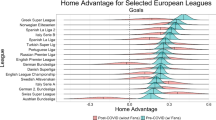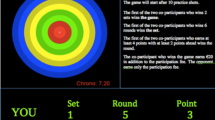Abstract
We analyze the time series of soccer matches in a model-free way using data for the German soccer league (Bundesliga). We argue that the goal difference is a better measure for the overall fitness of a team than the number of points. It is shown that the time evolution of the table during a season can be interpreted as a random walk with an underlying constant drift. Variations of the overall fitness mainly occur during the summer break but not during a season. The fitness correlation shows a long-time decay on the scale of a quarter century. Some typical soccer myths are analyzed in detail. It is shown that losing but no winning streaks exist. For this analysis ideas from multidimensional NMR experiments have been borrowed. Furthermore, beyond the general home advantage there is no statistically relevant indication of a team-specific home fitness. Based on these insights a framework for a statistical characterization of the results of a soccer league is introduced and some general consequences for the prediction of soccer results are formulated.
Similar content being viewed by others
References
E. Ben-Naim, S. Redner, F. Vazquez, Europhys. Lett. 77, 30005 (2007)
E. Ben-Naim, N.W. Hengartner, Phys. Rev. E 76, 026106 (2007)
J. Wesson, The Science of Soccer (Institute of Physics Publishing, 2002)
M. Tolan, M. Paulus, R. Fendt, J. Stolze, preprint (2007)
E. Bittner, A. Nussbaumer, W. Janke, M. Weigel, Europhys. Lett. 78, 58002 (2007)
R. Mantegna, H. Stanley, Nature 376, 46 (1995)
L. Malacarne, R. Mendes, Physica A 286, 391 (2000)
D. Gembris, J. Taylor, D. Suter, Nature 417, 506 (2002)
A. Lee, Chance 10, 15 (1997)
M. Dixon, S. Coles, Appl. Statist. 46, 265 (1997)
M. Dixon, M. Robinson, The Statistician 47, 523 (1998)
H. Rue, O. Salvesen, The Statistician 49, 399 (2000)
R. Koning, The Statistician 49, 419 (2000)
S. Dobson, J. Goddard, Euro. J. Operational Res. 148, 247 (2003)
N. Hirotsu, M. Wright, J. Quantitative Analysis in Sports 2, 1 (2006)
K. Schmidt-Rohr, H.W. Spiess, Phys. Rev. Lett. 66, 3020 (1991)
A. Heuer, M. Wilhelm, H. Zimmermann, H.W. Spiess, Phys. Rev. Lett. 75, 2851 (1995)
R. Boehmer, G. Hinze, G. Diezemann, B. Geil, H. Sillescu, Europhys. Lett. 36, 55 (1996)
S. Stigler, Statistics on the Table. The History of Statistical Concepts and Methods (Harvard University Press, 2002)
J. Goddard, I. Asimakopoulos, J. Forecasting 23, 51 (2004)
S. Dobson, J. Goddard (2001), http://citeseer.ist.psu.edu/426358.html
J. Atkinson, Psychological Rev. 359 (1957)
N. Hirotsu, M. Wright, The Statistician 52, 591 (2003)
Author information
Authors and Affiliations
Corresponding author
Rights and permissions
About this article
Cite this article
Heuer, A., Rubner, O. Fitness, chance, and myths: an objective view on soccer results. Eur. Phys. J. B 67, 445–458 (2009). https://doi.org/10.1140/epjb/e2009-00024-8
Received:
Revised:
Published:
Issue Date:
DOI: https://doi.org/10.1140/epjb/e2009-00024-8




